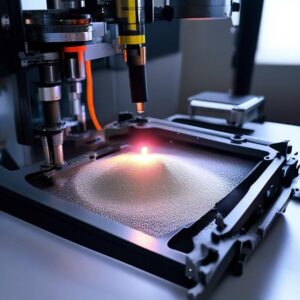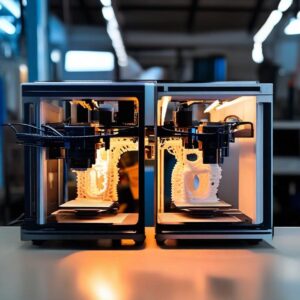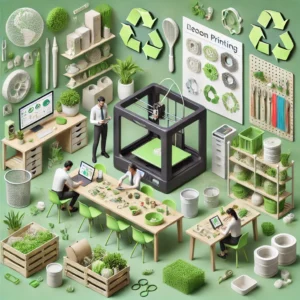Exploring 3D Printing Technologies: From FDM to Emerging Innovations

3D printing has evolved into one of the most revolutionary manufacturing technologies, offering vast applications across industries. From rapid prototyping to full-scale production, different 3D printing technologies provide unique benefits and challenges. This article explores the core 3D printing methods, including FDM, SLA, SLS, and DMLS, along with emerging innovations shaping the future of additive manufacturing.
Understanding Fused Deposition Modeling (FDM) Printing
Fused Deposition Modeling (FDM) is the most widely used 3D printing method, known for its affordability and ease of use. This process involves feeding a thermoplastic filament through a heated nozzle, where it is melted and deposited layer by layer onto a build plate. The material then cools and solidifies, gradually forming a three-dimensional object.
The step-by-step process of FDM printing begins with filament selection. Popular materials include PLA, ABS, PETG, and TPU, each with distinct properties suited for different applications. The filament is then fed into the printer’s extruder, which melts the material and pushes it through a nozzle onto the build platform. The printer follows the digital design, extruding material in layers to build the object from the bottom up. Once the model is completed, cooling and post-processing steps, such as sanding or painting, enhance the final print.
FDM printing offers several advantages, including affordability, accessibility, and the ability to print large objects. It supports various thermoplastics and allows for easy modification of designs. However, it has limitations, such as visible layer lines, weaker mechanical properties compared to other printing methods, and the need for support structures for overhanging features. Despite these drawbacks, FDM remains the go-to choice for hobbyists, educators, and engineers developing prototypes.
Stereolithography (SLA) – High-Resolution Resin Printing
Stereolithography (SLA) is an advanced 3D printing technology that utilizes a liquid photopolymer resin, which is cured layer by layer using a UV laser or LCD light source. This method produces high-resolution, smooth surface finishes and intricate details, making it ideal for applications requiring precision.
The SLA printing process begins with a resin vat, where a build platform is submerged into the liquid resin. A UV laser selectively cures specific areas of the resin, solidifying each layer. Once a layer is cured, the build platform moves slightly upward, allowing the next layer to be cured on top of it. This process continues until the full object is formed. After printing, the model undergoes post-processing steps, including washing in isopropyl alcohol (IPA) to remove excess resin, curing under UV light for additional strength, and sanding or painting for an improved finish.
SLA printing offers exceptional detail, smooth surfaces, and a wide range of resin materials, including standard, tough, flexible, and bio-compatible resins. However, it has some limitations, such as higher costs, the need for post-processing, and material brittleness compared to FDM prints. Despite these challenges, SLA is widely used in industries such as dentistry, jewelry, and prototyping, where precision is essential.
Selective Laser Sintering (SLS) – Powder-Based Printing
Selective Laser Sintering (SLS) is a powder-based 3D printing technique that uses a high-powered laser to fuse polymer powders, such as Nylon (PA11, PA12), layer by layer. Unlike FDM and SLA, SLS does not require support structures because the surrounding powder provides natural support, allowing for more complex geometries.
The SLS printing process starts with a thin layer of polymer powder evenly distributed across the print bed. A high-powered CO2 laser scans the layer, selectively sintering the powder to form the object’s structure. After each layer is sintered, the build platform lowers, and a new layer of powder is applied. This process continues until the object is fully formed. After printing, the model remains in the powder bed to cool gradually before excess powder is removed and recycled. Post-processing steps, such as sanding, dyeing, or vapor smoothing, improve the final appearance.
SLS printing offers several advantages, including the ability to create complex, durable parts without support structures. It is widely used in aerospace, automotive, and medical industries for functional prototypes and end-use components. However, SLS printing is expensive, requires post-processing, and has a longer cooling time compared to FDM and SLA. Despite these limitations, SLS remains a popular choice for industrial manufacturing.
Direct Metal Laser Sintering (DMLS) – Advanced Metal Printing
Direct Metal Laser Sintering (DMLS) is a metal 3D printing technology that works similarly to SLS but uses metal powder instead of polymer powder. This process is widely used in aerospace, medical implants, and automotive industries for high-strength, complex metal parts.
The DMLS printing process begins with a thin layer of metal powder evenly spread across the build plate. A high-powered fiber laser selectively fuses the metal powder layer by layer, forming the object’s structure. Once a layer is fused, the build plate lowers, and a new layer of powder is applied. This process continues until the full object is completed. After printing, the model undergoes post-processing, including heat treatment, machining, and polishing to improve strength and surface finish.
DMLS offers several benefits, such as the ability to create high-strength, complex metal parts, ideal for aerospace and medical applications. However, it has some drawbacks, including high costs, the need for post-processing, and slower printing speeds compared to polymer-based methods. Despite these challenges, DMLS is revolutionizing industries that require custom, high-performance metal components.
Emerging Innovations in 3D Printing (2025 Trends)
Several emerging 3D printing technologies are reshaping the industry as of 2025. One such advancement is Volumetric Additive Manufacturing (VAM), which prints entire objects simultaneously using a holographic light field, reducing print times drastically. Another innovation is multi-material and multi-color 3D printing, allowing printers to use multiple filaments or resins simultaneously to create functional, flexible, and aesthetic parts.
Sustainability is also a key focus, with new biodegradable and recycled filaments being developed to reduce environmental impact. Bioprinting is another groundbreaking field, with scientists using 3D printing to create human tissues and organs, paving the way for personalized medicine. Additionally, 3D-printed electronics and circuitry are advancing, enabling the integration of circuits directly into printed objects. These innovations are pushing 3D printing into new frontiers, making it a crucial technology for the future of manufacturing.
Latest News and Developments in 3D Printing (Jan-Feb 2025)
Several exciting developments in 3D printing have emerged in early 2025. A leading manufacturer has unveiled a high-speed SLA printer that reduces print time by 70%, making SLA printing more efficient than ever. NASA has successfully 3D-printed a prototype lunar base using regolith-based materials, bringing space colonization closer to reality.
A medical startup has developed a 3D bioprinter capable of printing human skin layers, revolutionizing burn treatment. Additionally, companies are launching sustainable 3D printing materials, such as recycled and biodegradable filaments, to minimize the environmental impact of plastic-based printing. The automotive industry is also adopting large-scale metal 3D printing, with major automakers mass-producing complex metal car parts using DMLS technology to cut production costs. These advancements highlight the rapid growth and impact of 3D printing across industries.
The Future of 3D Printing
3D printing is rapidly evolving into a mainstream manufacturing technology. While FDM, SLA, and SLS continue to dominate, emerging technologies like bioprinting, volumetric printing, and multi-material 3D printing are paving the way for next-generation applications. As costs decrease, print speeds increase, and material options expand, 3D printing will revolutionize medicine, aerospace, construction, and consumer products.
Understanding the core 3D printing technologies and their latest innovations allows businesses, engineers, and hobbyists to fully leverage the potential of additive manufacturing in 2025 and beyond.
For other insights and projects, be sure to explore our Key Technologies in 3D Printing or Uses of 3D Printing




